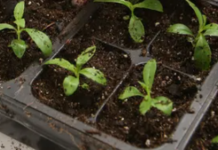Now is a good time to begin control measures for iris leaf spot by removing old, dead leaves. Iris leaf spot is a fungus disease that attacks the leaves and occasionally the flower stalks and buds of iris. Infection is favored by wet periods during the spring, and emerging leaves eventually show small (1/8- to 1/4-inch diameter) spots. The borders of these spots are reddish, and surrounding tissue first appears water-soaked, and then yellows. Spots enlarge after flowering and may coalesce. The disease tends to be worse in wet weather and may kill individual leaves. Though the disease will not kill the plant directly, repeated attacks can reduce plant vigor so that the iris may die from other stresses. Spores are passed to nearby plants by wind or splashing water.
Because this disease overwinters in old leaves, removal and destruction of dead leaves will help with control. For plants that had little infection the previous year, this may be all that is needed. Plants that were heavily infected last year should be sprayed with chlorothalonil (Bravado Fungicide, Fertilome Broad Spectrum Landscape & Garden Fungicide, Ortho Garden Disease Control, GardenTech Daconil, Bonide Fungonil, Bravo Flowable Fungicide) or myclobutanil (Immunox, Immunox Plus) starting when leaves appear in the spring. Repeat sprays every seven to 10 days for four to six sprays. Iris leaves are waxy, so be sure to include a spreader-sticker in your spray to ensure good coverage. (Ward Upham)
Contributors: Ward Upham, Extension Associate
Horticulture & Natural Resources
2021 Throckmorton, KSU
Manhattan, KS 66506
(785) 532-6173




